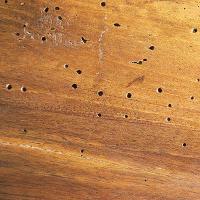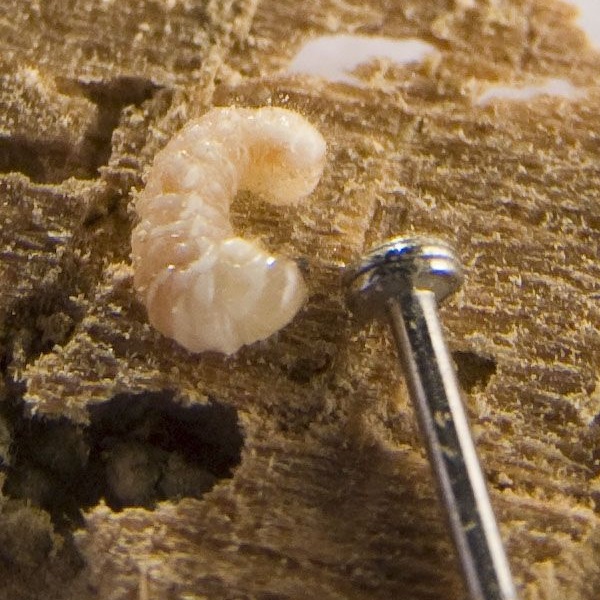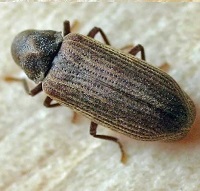Woodworm Treatment
Any woodworm treatment starts with understanding the problem and the clients requirements. That is why we first offer a free woodworm and damp survey. Our expert will visit and take the time to understand the full situation, explain & discuss the woodworm treatment solutions available. We can then propose the most cost effective, guaranteed solution that is right for your property and its occupants.
Landlord, home owner, or commercial property manager we understand that each client and each property is unique. At Damp 2 Dry Solutions we offer more than just pest control, we offer a guaranteed total solution to ensure that not just the woodworm is treated but also our experts can investigate and treat the damp conditions that cause woodworm, other insect infestations and the associated problems.
What Is Woodworm?
To understand the problem we first need to consider what is woodworm? Woodoworm is not a worm. Woodworm is a general term used to describe the wood boring larvae of an insect. There are various species of insects with wood boring larvae that can be found in domestic and commercial properties. The most common species of woodworm is the Common Furniture Beetle (Anobium punctatum). Occupied building are generally not a comfortable environment for woodworm. To thrive woodworm require a relative humidity above 60% however they can often persist in occupied buildings taking several years to complete their life-cycle instead of one. For this reason woodworm are often found in areas of a building that have chronic damp problems such as poorly ventilated basements, cupboards and roof voids. As the name common furniture beetle suggests, woodworm are often found in old furniture – especially is it has been stored in a damp cellar or outbuilding.
Other species of woodworm much less common in northern England include:
Death Watch beetle – larger, approximately 7 mm in length distinctive by the tapping/ticking sound they make to attract mates in old building rafters during quiet summer nights.
House Longhorn beetle – only really found in the south of England this woodworm leaves significantly larger holes.
Powderpost beetle – very small and reddish brown / black these woodworm larvae bore through seasoned wood such as ash, elm and oak.
Signs of Woodworm

Exit Holes – Or flight holes are small neat fresh round holes approximately one to two mm in diameter with sharp edges. These holes indicate that the woodworm larvae have been present inside the wood for some years feeding and growing to become adults, completing their life cycle by eating their way out of the timber. Unless the timber has been treated there will almost definitely be many more insect larvae active inside the wood.

Bore Dust – Faeces called frass, the debris from the woodworm larvae is an early tell tale sign of infestation. A cream-coloured powdery material which may feel gritty to the fingers if relatively fresh. This is seen under the infected wood and indicates that the woodworm are currently active. Inside the wood will be a growing network of unseen tunnels and galleries which if left untreated will weaken and damage the wooden structure of a building.

Woodworm Larvae – The adult female of the common furniture beetle lays her eggs in cracks, crevices or existing flight holes in timber. The tiny pearl like woodworm eggs are barely visible to the naked eye so usually go unnoticed. Within a few weeks the tiny larvae hatch and baby woodworms immediately burrow into the wood where they live for two to five years feeding, growing and causing structural damage to the timber. These larvae are the actual woodworms. They are greyish white in colour with a narrow dark band over the mouth parts and grow to about 6 mm long. The front part of the body appears relatively thick or hunched and has three pairs of visible legs. The rear section of the body is thinner, with a rounded tail-end.

Adult Beetles – Small brown beetle between 3-6 mm long – like most beetles they fly, so can easily move around and enter buildings. The adult beetles emerge from infected timber in the spring between May to August. The female beetle seeks out a suitable timber for the woodworm larvae to feed on and the male then finds the female by tracking the pheromones she releases. The adult beetles mate and then soon die without causing further damage to timber. Dead adult beetles are a common sign of an active woodworm infestation.
Woodworm treatment
For most woodworm infestations treatment typically involves spraying the affected timbers with an insecticide which eliminates beetles and larvae. With most sprays treated areas can be reoccupied that same day.
Our woodworm treatments use the latest water-based, insecticides to minimise any risk to occupants. We also offer woodworm treatments in the form of a liquid, paste or gel, applied by brush or injection as required. For example should we find a deep-seated death watch beetle infestation, our woodworm experts will use a deeply-penetrating insecticidal gel. Timbers which have been severely affected by a woodworm infestation may become structurally unsafe, so treatment may include cutting away and replacing infected timbers or repairs with specialist epoxy resin products.
Woodworm Survey
There are many factors to consider before undertaking a program of woodworm treatment so it is important to seek independent expert advice from a reputable company. An inspection and subsequent program for woodworm treatment should include:
- How widespread the woodworm infestation is – after all it may just be restricted to a piece of furniture.
- Whether the woodworm are still active – occupants may just be seeing the evidence of a previous infestation.
- What species of woodworm are present – some species of woodworm require more aggressive treatments.
- Whether there is any significant structural damage within the woodworm infected timbers.
- Investigation of chronic damp problems that have caused the woodworm to thrive.
- Consideration of the occupants and uses of the building.
Areas we cover
We have regional teams in the following areas.
We aim to provide a solution to your problems in Cheshire, Manchester & Lancashire, Liverpool & Merseyside, Leeds & North Yorkshire, Sheffield & South Yorkshire, Stoke-on-trent and surrounding areas. We offer a No-Obligation Damp Survey in these areas.
At Damp 2 Dry Solutions we do not offer one size fits all in woodworm treatment. We are driven by complete customer satisfaction. To achieve this we have a range of treatments, some exclusive to our company, combined with our expertise and understanding we deliver total solutions. Our solutions are crafted to the needs of our clients, their buildings and the occupants of those buildings, guaranteed, long term and cost effective.
You don’t just have to believe us read the feedback from our clients!
To book a woodworm survey from one of our expert surveyors, call 01606 872 691, Or complete the form at the to right right hand side of this page.
To find out more about our damp survey or our process for damp treatment explore our website.
